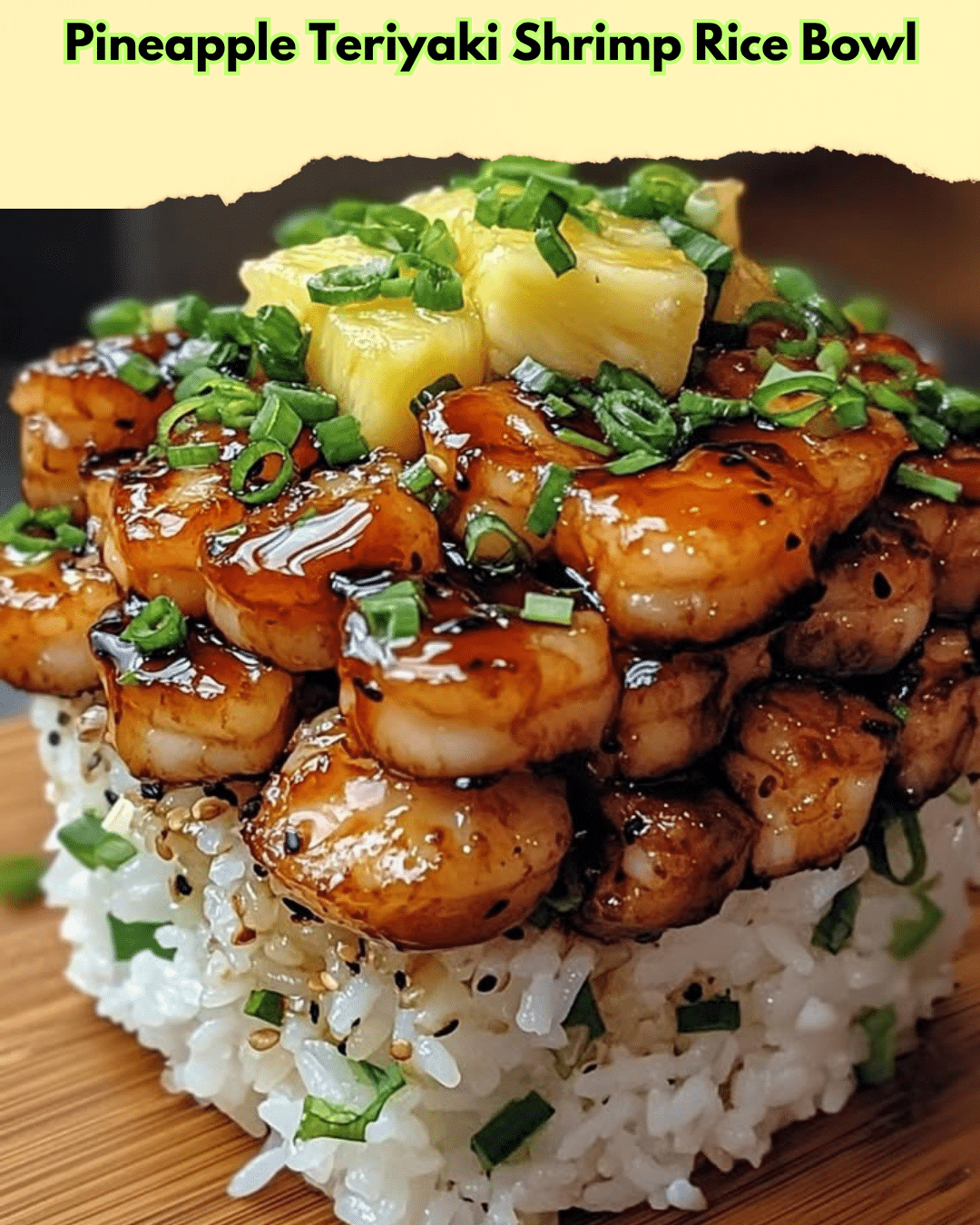Pineapple Teriyaki Shrimp Rice Bowl: A Delightful Fusion of Sweet and Savory
Introducing our vibrant Pineapple Teriyaki Shrimp Rice Bowl, a dish that perfectly embodies the harmony of sweet and savory flavors. This delightful recipe brings together succulent shrimp marinated in teriyaki sauce, complemented by juicy pineapple chunks and served on a bed of fluffy rice. With its quick preparation and impressive presentation, this meal is ideal for both weeknight dinners and entertaining guests.
Imagine biting into tender shrimp glazed with a sticky and savory teriyaki sauce, combined with the burst of sweetness from pineapple. The Pineapple Teriyaki Shrimp Rice Bowl is a sensory delight that combines different textures, from the juicy shrimp to the soft rice, with a touch of crunch from fresh vegetables like bell peppers and snap peas.
Aromatic notes from the teriyaki sauce and fresh pineapple will fill your kitchen, creating an inviting atmosphere that will draw everyone to the table. Visually, this dish dazzles with vibrant colors that range from the glazed shrimp to bright vegetables, making it as beautiful to look at as it is delicious to eat.
Quick Recipe Highlights
- Flavor Profile: The harmonious blend of sweet pineapples and savory teriyaki sauce brings a delightful balance to every bite.
- Texture: Enjoy the succulent and tender shrimp paired with soft rice and crisp vegetables, offering a rounded texture experience.
- Aroma: Expect a rich and inviting aroma from the teriyaki glaze, alongside fresh pineapple fragrances.
- Visual Appeal: The dish boasts a burst of colors with golden shrimp, vibrant green vegetables, and juicy pineapple pieces.
- Skill Level Needed: This recipe is straightforward and perfect for cooks of all levels, focusing on simple techniques that yield complex flavors.
- Special Equipment: All you need is a skillet or wok to bring this delicious dish together with ease.
Recipe Overview
- Difficulty Level: This dish is remarkably uncomplicated, featuring simple cooking steps such as stir frying and steaming, making it suitable for beginner to intermediate cooks.
- Category: This Pineapple Teriyaki Shrimp Rice Bowl falls under both main courses and rice dishes, ideal for lunch or dinner.
- Cuisine: Drawing inspiration from Asian flavors, this dish adds a tropical twist international cuisine enthusiasts will appreciate.
- Cost: With shrimp, rice, and a few fresh produce items, this dish is moderately priced, offering gourmet flavors without breaking the bank.
- Season: Suitable year-round, though especially perfect in summer when pineapple is in season and can be enjoyed at its freshest.
- Occasion: Whether a casual family meal or a dinner party, this recipe suits a range of occasions with its flavorful and appealing presentation.
Why You’ll Love This Recipe
The Pineapple Teriyaki Shrimp Rice Bowl offers an addictive combination of taste and texture. The succulent shrimp and juicy pineapple chunks nestle among fluffy rice, each grain absorbing the balanced sweet and savory teriyaki flavors. The dish is also complemented by a bonus crunch from sliced vegetables, creating a satisfying mouthfeel overall.
Convenience is key, with this meal coming together in around 35 minutes. Pre-cut shrimp and ready-made teriyaki sauce reduce prep time, while the ingredients cook quickly in a single pan, simplifying cleanup. It’s a perfect choice for busy weeknights or impromptu guests.
Nutritionally, this recipe provides a lean source of protein from shrimp, healthy carbohydrates from rice, and essential nutrients from vegetables. Pineapple adds not only sweetness but also vitamin C and dietary fiber, making the dish wholesome and balanced.
The social aspect of this dish cannot be overstated. Its vibrant appearance and rich flavors make it a fantastic centerpiece for gatherings where you want to impress without feeling overwhelmed. It’s versatile enough to suit varying palates, transforming an everyday meal into something extraordinary.
Without needing exotic or expensive ingredients, the Pineapple Teriyaki Shrimp Rice Bowl remains cost-effective. Most of the ingredients are pantry staples or readily available at local markets, and shrimp offers a decadent touch without excess cost relative to other seafood.
Historical Background and Cultural Significance
Originating from a blend of Asian culinary traditions, the teriyaki method of cooking involves grilling meat and glazing it with a soy sauce-based mixture. This technique, originating in Japan, has been embraced worldwide for its simplicity and the incredible depth it imparts to dishes like our Pineapple Teriyaki Shrimp Rice Bowl.
Historically, teriyaki sauce was initially used for fish, highlighting the dish’s roots in seafood-based cuisines. As it evolved, variations emerged, integrating different proteins such as chicken and beef, and, of course, shrimp, which pairs beautifully with tropical fruits like pineapple.
Through its evolution, the dish has adapted to incorporate local ingredients and cultural preferences, allowing families around the world to personalize it. The addition of pineapple reflects international iterations, bringing a tropical flair that enhances its unique flavor profile.
Regionally, variations of this dish might feature a variety of vegetables depending on availability and preference. From using water chestnuts in Asia to incorporating bell peppers in the West, the adaptable nature of this dish allows countless versions, each unique yet tied by the classic teriyaki method.
Ingredient Deep Dive
Pineapple is not only a sweet addition; it’s a powerful fruit filled with nutrients. Historically a prized tropical fruit, its inclusion brings a burst of flavor, while its vitamin C and manganese support immune function and bone health. Choose pineapples with firm, fresh skin and a sweet aroma for the best quality.
Shrimp offer high-quality protein without excess fats, a staple in many coastal cuisines globally. They can be easily stored frozen and thawed as needed, offering convenience and versatility. When selecting shrimp, opt for raw rather than pre-cooked for more control over the dish’s flavor and juiciness. Store shrimp at the back of the freezer to avoid temperature fluctuations.
Teriyaki sauce is the heart of this dish, combining soy sauce, sake, and sugar to create the signature glaze. When purchasing, aim for brands offering natural ingredients to avoid unnecessary additives. Once opened, keep teriyaki sauce refrigerated to maintain freshness.
Common Mistakes to Avoid
- Avoid overcooking shrimp to prevent them from becoming rubbery. Cook until opaque and slightly pink.
- Do not over-saturate the rice with sauce; aim for balance in flavor without becoming mushy.
- Incorporating too many vegetables can dilute the dish’s flavors, so use them sparingly.
- Ensure pineapple chunks are fresh, as canned options may add unnecessary liquid and sugars.
- Improper heat control can burn the teriyaki sauce, leading to bitter flavors. Cook on medium heat to ensure a glossy glaze.
- Be careful with timing the incorporation of ingredients; vegetables should remain vibrant and fresh.
- Avoid heavy salt use; the teriyaki sauce already contributes significant seasoning.
- Skipping the resting step for rice can lead to sticky or clumpy grains, so let it rest for perfect fluffiness.
- Undercooking rice will detract from the intended texture, so ensure it’s fully cooked before assembling the bowl.
- Ignoring aesthetic presentation can lessen the dish’s impact, so plate thoughtfully for the best dining experience.
Essential Techniques
Mastering the glaze technique involves allowing the teriyaki sauce to coat the shrimp evenly for a shiny, flavorful finish. Stir constantly to avoid burning, and watch for a deep, lustrous color which indicates caramelization of sugars.
Perfecting rice cooking is crucial. Use a rice cooker or heavy-bottomed pan to achieve evenly cooked grains. Maintain a 1:2 rice-to-water ratio, and don’t lift the lid during cooking to preserve steam and prevent drying out.
Controlling pan heat ensures even cooking without burning. Use medium heat, and adjust as needed when including various ingredients, especially those containing sugars like pineapple and teriyaki sauce.
Pro Tips for Perfect Pineapple Teriyaki Shrimp Rice Bowl
Boost flavor by marinating shrimp in teriyaki sauce for at least 15 minutes before cooking. This step infuses the shrimp with deeper, richer flavor from within.
Use fresh pineapple for the best taste and texture. Canned varieties tend to be too sweet and can make the dish overly wet.
For added texture variety, sprinkle sesame seeds over the finished dish. This garnish adds nuttiness and a subtle crunch that contrasts with the tender shrimp.
Opt for jasmine or basmati rice for optimal fluffy results. These varieties naturally become fragrant and complement the dish’s tropical notes.
To enhance sauce thickness, simmer the teriyaki sauce for a few minutes before tossing it with the shrimp. This reduction elevates its taste and ensures the right consistency.
For those who enjoy spice, adding a dash of red pepper flakes introduces a gentle heat that enhances the sweet and savory dynamic.
Variations and Adaptations
Across regions, ingredients may vary. In some areas, using papaya instead of pineapple brings a similar sweetness with a softer texture. Alternatively, swap shrimp with grilled chicken for a land-based protein alternative.
In colder months, consider using comfort-heavy vegetables like carrots drizzled in teriyaki to incorporate sought-after warming properties in the dish. This seasonal adaptation maintains the dish’s core while providing seasonal texture and warmth.
For a coleslaw-inspired adaptation, serve vegetables raw on the side rather than mixed in. This option allows different textures and offers visual appeal, remaining vibrant against the warm shrimp.
Vegan versions can swap shrimp for mushrooms, such as shiitake, offering an umami-rich result without any animal proteins, ensuring it remains accessible across dietary preferences.
Serving and Presentation Guide
For an appealing presentation, use wide, shallow bowls to layer rice, vegetables, and shrimp. Stagger pineapple chunks and sprinkle green onions for a bold color highlight.
For garnish, sliced avocado adds creaminess, enhancing the presentation’s color palette and offering a foil to the dish’s central flavors.
Traditional accompaniments might include miso soup, pairing the bowl with subtle umami elements that contrast the sweetness and keep taste buds intrigued.
Modern serving suggestions might present the bowl deconstructed, allowing diners to tailor their flavor combinations. It offers personal control and showcases each component’s visual allure.
Temperature plays a role in enjoyment; refrain from serving excessively hot. Warm servings accentuate teriyaki’s richness, balancing textures without overshadowing pineapple freshness.
Proper portioning is important—aim for a balance of rice, protein, and vegetables in each serving to ensure consistent flavor and satisfaction across each bowl.
Wine and Beverage Pairing
Pairing a lightly chilled Riesling wine can enhance the dish’s sweetness, aligning naturally with pineapple without overwhelming the palate. Its floral notes finish strong against the teriyaki’s umami balance.
Non-alcoholic alternatives include a crisp, chilled green tea, delivering tannins that cleanse the palate between bites, suitable for meals with diverse eaters or age groups.
Consider pairing coffee with a gentle cinnamon finish during brunch selections. This warmth plays against the tropical overtones, ensuring a delightful juxtaposition.
Serve beverages slightly chilled, matching the dish’s vibrant spirit. Cold sipping refreshes between bites, offering a continuum of enhanced enjoyment.
Plating beverages smartly beside the bowl, ensure accessibility and seamless inclusion in the meal’s overall design. Placement enhances coordination between dish presentation and accompanying drink.
Storage and Shelf Life
Store leftovers in airtight containers, separating rice, shrimp, and vegetables when possible to maintain texture integrity. Keeping elements apart deters moisture seepage and prolongs freshness.
Maintain optimal storage temperature by refrigerating within two hours of initial preparation, aiming for a chilled zone under 40°F (4°C) for best safety practices.
Containers should be stable, avoiding flavor transfer. Sandwich bags may suffice for separated ingredients, but stiffer plastic can preserve best results.
After refrigeration, consume within 2-3 days to align with seafood freshness. Visually inspect rice for color changes, and sniff for undesirable aromas indicating spoilage.
For reheating, employ gentle steaming or microwave-safe covers, preventing moisture loss. Heat until shrimp are warm throughout; overly dry rice can be revived with a splash of water during reheating.
Freezing shrimp separately ensures quality extension, reducing icy buildup in rice. Thaw portions overnight in the refrigerator before reheating to support best texture retention.
Make Ahead Strategies
Prepare individual components ahead—slice vegetables, cook rice, and blend teriyaki sauce—assembling just before serving to maintain maximum freshness.
Consider a prep timeline breaking down daily stages, such as marinading shrimp in advance, leaving assembly simple and efficient when hunger strikes.
Assess quality impact: for cold versions, allow flavors to meld overnight. However, avoid advance dressing with teriyaki sauce, which can overly saturate pre-cooked rice.
Reserve fresh elements until serving. Final touches like green onions or a squeeze of lime accomplishes a burst of flavorful brightness, complementing pre-prepped core elements with finesse.
Ensure reheating guidelines align with preservation. Distribute heat evenly across individual sections for even warming without drying shrimp or clumping rice.
Fresh additions like sliced avocado or sesames just before dining prevent nutrient degradation or texture loss during make-ahead phases.
Scaling Instructions
To halve the recipe, divide marinade and rice proportionally—a medium saucepan suffices for reduced quantities, ensuring control over cooking precision.
Increase serving size by doubling, employing a larger skillet to accommodate ingredients without overcrowding, promoting even heat distribution, and reducing steaming potential.
Equipment adjustments, such as using an additional cooking surface, may prevent backlog if scaling up—enabling simultaneous shrimp and vegetable preparation without added stress.
Expect timing variations, accounting for extended cooking when increased quantities are involved. Stir frequently to eliminate uneven cooking at larger volumes.
Store extra portions appropriately, ensuring containers match expanded food volume for seamless storage without compromising flavor quality.
Consider cooling intervals and storage container quantity growth when managing expanded recipe output, preventing dense layering and spillage risk.
Nutritional Deep Dive
A Pineapple Teriyaki Shrimp Rice Bowl offers a balanced macronutrient profile: healthy carbs from rice, lean protein from shrimp, and essential fats added through nuts and oils, supporting a nutritious meal framework.
Micronutrient inclusion through vegetables like bell peppers boosts vitamin A and C, while pineapple introduces bromelain, an enzyme assisting digestion, enhancing the dish’s health benefits.
Tailoring portion sizes allows dietary compliance without sacrificing enjoyment potential, maintaining a portion-conscious approach to meal satisfaction.
Health-wise, low-fat shrimp enriches substantial muscle-building protein, essential in phenylalanine and lysine. This nutrient profile assists overall balanced diet models focused on well-rounded consumption.
Dietary considerations like gluten avoidance or reduced sodium intake can adapt the dish through rice variety changes or substituting coconut aminos, offering custom-fit nutrient profiles.
Weight management can benefit from utilizing brown rice or cauliflower rice for a nutrient-dense alternative with fuller fiber content, supporting a diverse caloric approach.
Dietary Adaptations
Modify the dish gluten-free by switching to tamari sauce instead of standard teriyaki, alongside certified gluten-free rice or grain alternatives.
Dairy-free preparations are straightforward: utilize oil rather than butter for vegetable sauté steps, maintaining the dish’s flavor standard without compromise.
Veganize the recipe through shrimp substitution with firm tofu cubes, facilitating teriyaki marinade absorption for an equally fulfilling, plant-based entree.
Low-carb enthusiasts might enjoy replacing rice with cauliflower rice, ensuring texture retention while significantly lowering carbohydrate content.
Keto followers can balance macros by focusing on high-fat coconut oil for cooking, ensuring reduced rice quantities paired with increased avocado slices to suit ketosis demands.
The Paleo diet sees a coconut amino switch and sweet potatoes in place of rice, complying with staple norms aligned with ancestral-style eating habits.
Its low-FODMAP version involves opting for green onions sparingly in lieu of regular, avoiding shrimp if intolerant, focusing on low-agitation alternatives.
Troubleshooting Guide
If textures become unappealingly mushy, refine individual cooking times— undisciplined mixing or over-saturation can turn components into lackluster parts.
To address blandness, gradually build flavors through better spice incorporation like ginger or garlic in early cooking stages, establishing more robust taste bases.
Control temperature for even cooking, prevent burnt shrimp through shorter high-heat exposure; recognize golden-browning signals optimal doneness without flare-ups.
Equipment malfunction, such as insufficient flame height, can necessitate equipment shifts to achieve recommended heat heights for shrimp’s fast cooking profile.
For ingredient scarcity, improvise subcomponents creatively; chicken replaces shrimp, apple subs pineapples, maintaining a flavor narrative through sensible pairing.
Timing missteps require modulating attention on peripheral aspects like sauce viscosity; incrementally adding corn-starch slurry can conquer thinner consistency regrets.
Recipe Success Stories
Our community has embraced the Pineapple Teriyaki Shrimp Rice Bowl as a go-to recipe favorite. Feedback admires the simple ingredient requirements that transform into complexly nuanced flavors even beginners can master quickly.
Variations showcase creative approaches like grilling instead of stir-frying shrimp, infusing rustic notes into base plates—an adaptation success thanks to feedback.
Reader suggestions have introduced garnishing innovations like fresh cilantro twists and zestier finishes with lime ginger vinaigrettes, broadening the flavor landscape.
Photography techniques suggest capturing the dish’s color spectrum under natural light for mouthwatering impact, effortlessly elevating visual presentation.
Adaptation tales bring stories of ingredient heroics surfacing—substituting mangoes for pineapples during autumn bestows a warmer palette with equally joyous outcome.
Frequently Asked Questions
What type of rice pairs best? We recommend jasmine or basmati rice due to their fragrant aroma and light texture, complementing the dish perfectly.
Could I make this dish spicier? Absolutely, try adding a dash of chili flakes or sriracha to the teriyaki sauce for a delightful kick of heat.
How can I incorporate more vegetables? Feel free to add vegetables like broccoli, snap peas, or zucchini for extra crunch and nutritional value.
Is there an alternative to shrimp? Chicken or tofu are great alternatives, offering different textures and protein profiles, adding variety to the dish.
How do I prevent the shrimp from overcooking? Cook them on high heat right until they turn pink and opaque; this will retain their natural tenderness.
What if I don’t have teriyaki sauce? DIY a quick version mixing soy sauce, honey, ginger, and garlic until you achieve similar depth and sweetness.
Can I make this recipe ahead of time? Yes, prepping components in advance is possible; simply store separately and assemble just before serving for maximum taste.
Does reheating affect flavors? Reheating is best done gently to avoid drying; steaming or microwaving with added moisture ensures flavors remain intact.
What sides complement this bowl? Serving this recipe with light sides like miso soup or a crisp green salad perfectly balances the meal.
Can this recipe be grilled instead? Definitely, grilling shrimp imparts a smoky flavor that wonderfully enhances this bowl’s overall taste.
Is there a no-cook version possible? Substituting grilled shrimp and using pre-cooked rice offers a quick version, embracing the minimal cook time for swift assembly.
Additional Resources
Dive deeper into Asian cooking with guides focusing on perfecting rice, teriyaki techniques, and exploring other Asian-inspired recipes like sushi bowls or bibimbap that expand culinary adventures.
Unlock method success through video series on advance slicing skills and sauce emulsification practices, turning amateurs into pasta-making professionals thanks to clear, visual explanations.
Explore ingredient insights about artisanal soy sauce variations or tropical fruits, appreciating the hidden nutritional tapestry capable of transforming everyday dishes into health-oriented delights.
Arm your kitchen with recommended gadgets like rice cookers or steamers, unleashing techniques that amplify recipe efficiency, saving time for what matters — the meal itself!
Explore seasonal variations inspiring adaptation according to organic produce schedules, offering a guide to maximizing flavor profiles’ freshest potential, celebrating nature’s abundant offering year-round.
Print
Pineapple Teriyaki Shrimp Rice Bowl
Description
A delightful combination of sweet and savory flavors with succulent shrimp, pineapple, and rice.
Ingredients
For the Crust:
- 1 pound large shrimp, peeled and deveined
- 1 cup pineapple chunks
- 1 cup teriyaki sauce
- 2 tablespoons vegetable oil
- 2 cups cooked jasmine rice
- 2 green onions, sliced
Instructions
1. Prepare the Crust:
- Heat vegetable oil in a large pan over medium heat.
- Add shrimp to the pan and cook until pink and opaque, about 3-4 minutes per side.
- Add pineapple chunks and teriyaki sauce to the pan, stirring to combine. Cook for an additional 5 minutes.
- Serve the shrimp and pineapple over a bed of cooked jasmine rice.
- Garnish with sliced green onions before serving.
Notes
You can customize the seasonings to taste.




